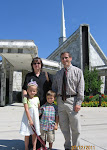On various forums, I have seen a lot of questions about Building Foundations of Scientific Understanding, K-2 by Dr. Bernard Nebel ("BFSU"). Since we recently started using this book, I thought I would share my own review.
I purchased BFSU a couple of months ago with the intention of using it in the fall. After seeing the book, though, I ditched the $100 1st-grade science that I thought I loved, because BFSU was so much better. Dr. Nebel knows science and knows children, and that is a rare combination. And for a quarter of the price, I received three times the volume of lesson plans.
What is BFSU?
BFSU is neither a traditional nor a classical science curriculum. Rather, it is an entirely new approach to teaching science. There are two main ideas that drive this curriculum: (1) People learn more when it is relevant to their own lives, and (2) People retain more of what they learn if they are making mental connections. BFSU attempts to create and take advantage of "teaching moments," that is, those times when children are seeking to learn, asking questions and wanting to know. Although it is not marketed as using the Socratic method, I find the Socratic method used heavily to create these "teaching moments."
BFSU covers the following general areas of science, called "threads": Nature of Matter, Life Science, Physical Science, and Earth and Space Science. There is not a specific schedule or order in which you have to teach the lessons. The lessons, however, are intended to be taught approximately in a spiral such that you are teaching one or two lessons from one thread and then moving on to the next. Each lesson plan tells you what lessons from all threads that are considered prerequisite. The earlier lessons are designed for the younger K level students, and the later lessons for the older students. In this way, the child learns to integrate the different areas of science. (For example, before teaching the distinction between plants and animals from the Life Science thread, the child should first have covered concepts of energy and making things go from the Physical Science thread, since how we get our energy is an important distinction between plants and animals.) As you spiral through the different threads, you continue to revisit what you have previously covered but just go into it in greater depth each time.
BFSU is written for the classroom, but it is very easily adaptable to the home school setting (and even acknowledges this in the Introduction). It is not just "for" K-2 students, but there are easily enough lessons for three years of material, unless you have a child that is extraordinarily driven in the science category. To quote another forum post, "This is not a cutesy Kindergarten science program." BFSU tackles some very advanced concepts while managing to keep the activities and material on a young child's mental level. (For example, DH is a high school physics teacher, and he has remarked that most of his new students have never even heard of the difference between mass and weight, a concept that is dealt with in the Physical Science thread.)
Is it secular or religious?
BFSU is a secular text. But as a Christian, I have not found anything controversial. It does not address topics like the creation of the world or evolution.
What kind of preparation does BFSU take?
Each lesson is very thorough and lengthy, most covering 6-8 pages, single-spaced, with no pictures or diagrams. It is absolutely necessary to read the whole lesson carefully. Dr. Nebel is meticulous about giving you everything you might want to know, including what misconceptions children commonly have, and what answers you might expect to get out of them.
A materials list is given for each lesson. Almost every material needed is something that you would likely have in your home, but occasionally you might find something that you need to pick up. As I browse through the lessons, I see that I will have to be prepared to acquire balloons for one lesson and an empty glass jar for another. My recommendation is to go through the materials lists for all of the lessons and make a shopping list of things you don't normally have and then store those things in an easily accessible location.
Each lesson also comes with a list of reading books that you can use with the lesson. So if you are using these book lists to supplement your lessons, you will need to check those out from the library prior to the lesson, as well.
The most difficult part of preparing for a lesson is that most of us will need to change how we teach and think about science. You have to figure out how you are going to make the lesson relevant to your own child. There are many ideas and lots of guidance, but BFSU recognizes that different children will be reached in different ways. It might be as simple as planning to talk about solids, liquids and gases in the bathroom as your child brushes his teeth or takes a bath. Or you might be inspired to elaborate on a given activity or go on a field trip. I do not personally like a scripted program, yet I lack the creativity to come up with my own activities and discussions. BFSU gives me just enough script with a whole lot of ways to tailor it to my own child, family and circumstances.
But just let me warn that BFSU does take some preparation. I am spending at least 30-60 minutes reading the lesson and setting up the activities, with most of that time spent just wrapping my brain around the lesson plan. If I did not have a science background, I would want to write down the questions I was supposed to ask and the answers I wanted to elicit from the child.
What about students older than K?
Dr. Nebel has been saying on his Yahoo group that books for grades 3-5 and for 6-8 are due out by this summer. In my opinion, you could easily use this book for grade 3 unless you have a particularly savvy student. Even with an older student that is really into science, I think much could still be gleaned from these lessons. I would just go through it faster. If I had a third grader, I would get the K-2 book and start working on it now so that I would not have to worry about when the 3-5 book came out.
If you have any questions, please post them, and I will add to this review.
Subscribe to:
Post Comments (Atom)


Yes, we love this curriculum, too! My favorite part is how specifically and explicitly everything is connected instead of just approaching science in a series of random lessons. It makes so much more sense (both to me and to my children) this way. I have been meaning to post a review on my blog for a while, but I haven't had time. Thanks for yours--I'll be sure to link to it!
ReplyDeleteThanks so much for this very thorough review!
ReplyDeleteGreat review - and accurate as well :)
ReplyDeleteThanks so much for the detailed review! I have a 4-year-old preschooler and we are just starting to look through curricula. This sounds like a great resource.
ReplyDelete